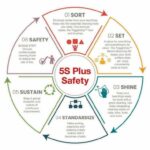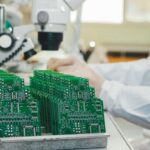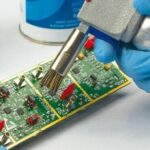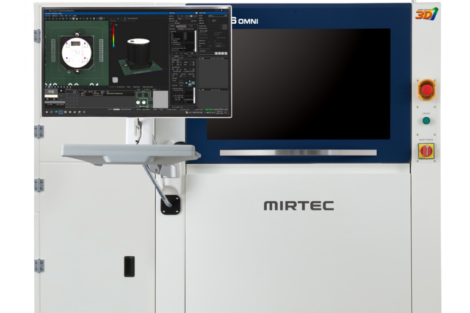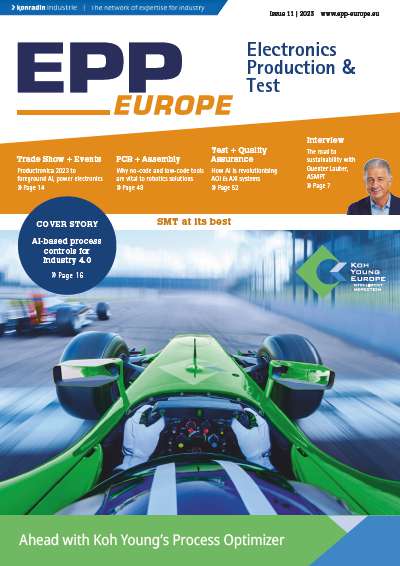Although PCB shortages may be starting to stabilise, but the electronics industry continues to feel their impact. Exacerbating this issue for PCB manufacturers is the fact that the electronic components market continues to rapidly expand – with the sector predicted to grow by USD 122.44 billion (EUR 116 billion) between 2022 and 2027, at a CAGR of 7.02%. To avoid delays, PCB fabricators must find flexible and innovative strategies to ensure production continues. Options may include modifying designs or using alternative parts, but there is a more obvious solution: increase efficiency by decreasing waste.
Electronics manufacturers must implement methods to ensure every electronic component is optimally utilised. An effective way to do this is to adopt tried and tested lean manufacturing processes such as the 5S methodology. This approach benefits all kinds of production environments and can be an extremely valuable process in PCB production, and especially benchtop cleaning. Adopting the 5S lean manufacturing method can help PCB manufacturers achieve better cleaning results at the benchtop, and thus increase efficiency and yield by reducing the number of faulty components and boards that land in the scrap pile.
What is 5S?
The 5S philosophy can be summed up as: ‘a place for everything and everything in its place’. The name refers to five Japanese words beginning with ‘S’ that represent a 5-step process to organize the working environment. These terms can be translated into 5 comparable English words:
- Seiri/Sort: Separate tools/components that are necessary from those that are not.
- Seiton/Set: Organise and categorise tools/components for ease of access and ease of use.
- Seiso/Shine: Clean up the working environment.
- Seiketsu/Standardise: Create standards and guidelines to uphold these practices.
- Shitsuke/Sustain: Follow the first four ‘S’s on a long-term basis by always maintaining the correct procedures.
Toyota first introduced something akin to the 5S methodology into its production in the 1950s – hoping to reduce manufacturing waste and inefficiency. It was discovered that by applying what later became known as the 5S concept, production ran more effectively because the workplace was clean and well-organised. This made it easier to see defects, all of which ultimately reduced waste and improved quality and output.
The 5S strategy offers a large number of benefits to companies that adopt it. As well as reducing waste and optimising productivity, it also helps to enhance safety, improve quality and reduce costs. It is estimated that efficiency gains of 10% to 30% can be achieved using this method.
5S and cleaning processes
One of the main causes of PCB failure is contamination. If not cleaned sufficiently, PCBs are susceptible to many problems – from electrochemical migration and delamination to parasitic leakage, dendrite growth and shorting. Cleaning is crucial to ensuring the reliable, long-term performance of a PCB. Cleaning processes should be quick and consistent. Implementing the 5S methodology helps achieve this goal.
Seiri / Sort
To begin, it is essential to look at all the items on the benchtop and ask yourself the following questions:
- Is this item necessary to clean the PCB and electronic components?
- When was it last used?
- Does it clean effectively?
In this way, you can determine which items on the benchtop are required for the job. Certain tools and cleaning fluids may have worked well last year but as new designs and components are introduced, these may no longer perform as they once did. A no-clean solder paste may have been added to the assembly process and the available flux remover may not be strong enough to remove the stubborn no-clean flux white residue, for instance. Perhaps a fragile or moisture-sensitive component has been added to the design which can only be hand-soldered. Selectively soldered PCBs usually undergo ‘spot-cleaning’ at the benchtop using aerosol flux remover and a brush but if the cleaning fluids are too strong for these delicate components, they can cause damage and result in scrapped boards.
A controlled cleaning fluid dispensing system is an essential tool on every PCB cleaning bench. When appropriately used, this system improves PCB cleaning results by targeting dirty areas on the board, getting under low-mounted components and permeating tight spaces for perfect for spot cleaning. It also controls the fluid flow to reduce waste and enhances worker safety by limiting the amount of cleaning fluid fumes released into the air.
Seiton / Set
The second step is ‘set’ or ‘straighten’. This is at the heart of the phrase ‘a place for everything and everything in its place’. All items that have been deemed necessary should be organized logically and methodically. This can be achieved by giving each a designated area and labelling it for quick identification. This lessens the need for extra inventory and cuts down on search time.
Think about how the cans of aerosol cleaning fluid are arranged on the work surface, for example. Removing aerosol cans and storing them in mounted holders on the work bench legs frees up workspace and keeps cleaning fluids easily accessible – meaning less time spent looking for the appropriate fluid.
Seiso / Shine
Shine refers to cleaning. Everything must be clean, tidy, and neatly stored in its place. How can the PCB or components be clean if the benchtop you are working from isn’t? If a benchtop is covered in dirt and dust, it will negatively affect the cleaning process and exacerbate other problems like electrostatic discharge (ESD).
ESD is a major cause of PCB failure and is estimated to cause a third of PCB losses. It occurs when a board comes in contact with an object with the opposite electrical charge and creates an ESD spike, This damages boards and their sensitive electronic components.
While it is impossible to prevent or eliminate all ESD, some practical ways to reduce it during SMT (surface mount technology) production include keeping the benchtop clean. Many work surfaces and tools used to assemble, clean and test PCBs hold static charges. It is important to dissipate the charges and remove the dirt by wiping down all tools and surfaces with pre-saturated, ESD-reducing cleaning wipes.
ESD wipes are formulated to remove grime, grease and fingerprints without leaving lint, residue or static charges behind. They are a good general cleaner that will not dry out the ESD mats, cause fissures or leave mats brittle. Cleaning with ESD pre-saturated wipes helps ensure tools, surfaces and equipment are both clean and non-conductive.
Seiketsu / Standardise
This step ensures that all the progress made in the first three steps are not for nothing. By standardising these steps, 5S becomes a repeatable process that every technician follows. Creating a checklist and ensuring all workers follow the same procedures, and carry out cleaning processes correctly, will help ensure that consistent, high-quality PCB cleaning becomes standard practice. This in turn will help to reduce waste.
Shitsuke / Sustain
Sustain is the final stage that helps technicians maintain all that has been implemented over the previous four stage. Companies must maintain the 5S procedures and update and adapt them as necessary.
It is essential to involve the entire workforce in the 5S approach: the management team, those working at the PCB cleaning workbench, and staff in inspection and quality control. Regular training is a good way to keep everyone updated on the process and to ensure long-term success.
The sixth ‘S’
An additional sixth step that some companies adopt when using the 5S methodology is ‘Safety’. It concentrates on eliminating workplace risks and raising standards.
It is important to examine cleaning fluids and equipment and carefully review the SDS (safety data sheets) to make sure they are appropriate for usage. Advanced PCB cleaning solutions are safer for exposed employees since they are designed to be non-flammable, have better toxicity profiles, and high threshold limit values (TLVs), making them safer for users.
As mentioned above, a controlled cleaning fluid dispensing system is an effective tool. Cleaning fluid is distributed through a closed aerosol system, restricting worker exposure to any gases and lowering the possibility of spillage and fire hazards.
As component shortages continue, PCB manufacturers are making every part count. Ineffective PCB cleaning not only affects the quality and reliability of any electronic device but can also leave the PCB unusable. When considering PCB cleaning, look for methods like ‘5S Plus Safety’ to help to optimise the process, and reduce waste.
Productronica, Booth A4.101
About the author
Elizabeth Norwood is a Senior Chemist at MicroCare, provider of precision cleaning solutions. She has been in the industry for more than 25 years and has a BS in Chemistry from the University of St. Joseph, Connecticut. Norwood researches, develops and tests cleaning-related products. She currently has one patent issued and two pending for her work.


